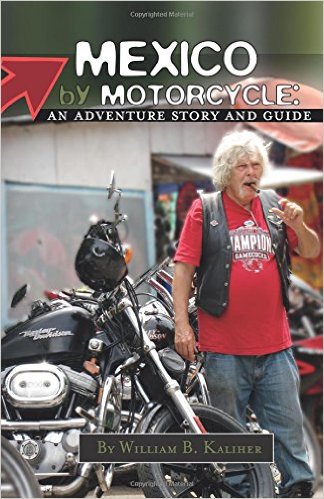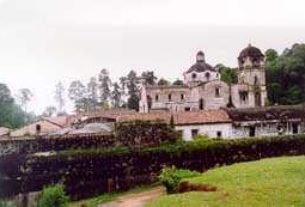Available from Amazon Books: Paperback and Kindle
William Kaliher’s book Mexico by Motorcycle is, for the most part, a user friendly mixed bag of suggestion and admonitions for the motorcyclist planning to travel Mexico by bike. But it’s also a bit more. Mr. Kaliher has been to Mexico many times over the years since his first bike trip in 1971. It’s evident he feels an attachment to the country beyond its exotic surface, and his affection for the people and the culture comes through strongly in the second half of his book. Throughout the book, the tone is chatty, closer to conversational than to formal language. It makes the read fast and easy.

The chapters in Mexico by Motorcycle fall into six sections and two parts. This permits the readers to select the areas of most interest to them. The whole second part of the book can be read by itself, and has its own feel and quality. The first section is less introspective and more practical. It includes his last motorcycle trip in 1993 and is more rushed. He tells the reader he has a time constraint, and the reader feels it. It reads like a whirlwind through many places, mostly while being wet and chilled. There is also an appendix that deals with information from budget to preparation, a list of what clothing to carry (most of which is common sense) to basic bike information. He also suggests with wry humour to bring his book.
A practical index is included at the very end of the book that can be referred to for quick reference to the places that Mr. Kaliher traveled through. It could prove helpful to a newcomer to Mexico since his journey took him into many small towns and villages. Should a biker want to visit a particular area, it would be a quick reference back to the place. My one frustration with his advice to bikers is that he was vague about the price of food and hotels as well as rules and regulations in the country because, as he notes, they change often – as do the roads.
I thought the bike information on the items to take for repair was incredibly extensive and probably invaluable. I don’t bike. But for an outsider, the number of items for repair sounded like the rider could open his own repair shop. It’s true that one could get stranded on an isolated road. On the other hand, at this time in Mexico, I don’t think it’s wise to take isolated roads, and Mexican mechanics have a genius for repairing anything, even making missing parts if necessary.
I appreciated Mr. Kaliher’s digression into some useful information for visitors to Mexico whether on motorcycle, traveling by bus, or hoping to settle in the country. Mexicans can’t say “no.” It’s impolite. What we think in our culture is lying, they consider not being rude. It is difficult to get correct directions to anything in Mexico. You have no way of knowing whether what you’re being told is true or not. All you know is that the informant will go out of his or her way to send you somewhere so as not to disappoint you. And as Mr. Kaliher mentions, this is as true when offering an invitation. The first consideration is not to disappoint you when you’re face to face. Being honest is less important.
For anyone seriously thinking of biking through Mexico, his book offers a wonderful gift – his Facebook page. On his Facebook are the names of Mexican motorcycle clubs and Mexican bikers to get in touch with. I believe that it’s the best way to get up-to-date information. And what a boon to have a network of contacts before starting out. Mr. Kaliher makes it clear that motorcycle clubs in Mexico are not motorcycle gangs. They have rules of conduct and a high standard of ethics.
Having said that, I don’t agree with the author that travelling through Mexico by bike is safe. Or that the only target of the drug cartels are other narcos. The border states aren’t the only locations where drug lords are active. I have Mexican friends who now fly to different cities when at one time they took the bus or drove. I have a friend from Veracruz whose brother was badly beaten and thrown from his car because of mistaken identity by a narco gang. I met a woman from Lebanon who told me when the war was raging in her country, and only a block away no apartment building was left standing; she had no feeling of danger because it wasn’t on her street at that moment. Until you are targeted, there’s always the sense that you’re out of the fray. Yes, crime happens all over, but it has been my experience in Mexico that if anything happens to you in Mexico, you are very much on your own as a foreigner.
If I were a biker today, I’d stay on safe and well-travelled roads. And I’d definitely make contact with local bikers on Mr. Kaliher’s facebook to get the “feel of the land.” Also, because the laws are so fluid in Mexico I’d heed his advice to get insurance information along with the legal aid that should come with the insurance. He reminds the reader that in Mexico you are guilty until proven innocent.
Although the book is by a biker for bikers, I was drawn into his insights and reflections on Mexico when he made his first trip down to the Yucatan in 1991. This section is alive with rich detail and genuine appreciation for the people, culture, and physical beauty of the region. I was immersed in his story of the isolated stretch of road along the jungle when his bike died – the description of the experience was visceral and brought me there. His observations and experiences in that adventure, and his sense of loss with the changes that the modern world brought were parallel to my own experience having been in the area in 1969 and again in 2010.
Another section that takes the book out of being just a guide for motorcyclists needing a roadmap and preparation guidelines, is the author’s admiration for the ancient stones and structures of this hybrid civilization. When he describes Mayan ruins, the aqueduct in Morelia or La Quemada in Zacatecas, you feel his admiration. And because Zacatecas is a city of stone, he lingers there and brings the reader into his appreciation.
Mr. Kaliher tells the reader his book is a quick thumbnail sketch. There is so much more. He is right. There is. He encourages the reader to read further to know the culture. I appreciated that suggestion as I share his affection for the country, the culture, and the people.


